Book contents
- Frontmatter
- Contents
- List of tables, figures, and maps
- Preface
- 1 Foundations of the slave traffic, 1600–61
- 2 Curaçao and the asiento trade, 1650–1730
- 3 The Dutch on the West African coast
- 4 Trade and politics on the African coast
- 5 Volume of African exports and origins of slaves
- 6 Organization and mechanics of the trade
- 7 The triangular trade
- 8 The Dutch plantation colonies under WIC monopoly, 1618–1738
- 9 The era of the free trade, 1730–80
- 10 The slaves: their treatment and mortality
- 11 Finances, marketing, and profitability
- 12 The end of the Dutch slave trade, 1781–1815
- Appendixes
- Bibliography
- Index
10 - The slaves: their treatment and mortality
Published online by Cambridge University Press: 16 September 2009
- Frontmatter
- Contents
- List of tables, figures, and maps
- Preface
- 1 Foundations of the slave traffic, 1600–61
- 2 Curaçao and the asiento trade, 1650–1730
- 3 The Dutch on the West African coast
- 4 Trade and politics on the African coast
- 5 Volume of African exports and origins of slaves
- 6 Organization and mechanics of the trade
- 7 The triangular trade
- 8 The Dutch plantation colonies under WIC monopoly, 1618–1738
- 9 The era of the free trade, 1730–80
- 10 The slaves: their treatment and mortality
- 11 Finances, marketing, and profitability
- 12 The end of the Dutch slave trade, 1781–1815
- Appendixes
- Bibliography
- Index
Summary
The slaves are the principal subjects in this study, yet so little is known of them except as groups and statistics. Only on very rare occasions was the name of an individual slave known, such as the slave, Ettin, who led an uprising as detailed in Chapter 7. They were generally identified by a number burned on their skin, either an individual number or one that identified them with the ship on which they sailed or the company that purchased them. Slaves were seen and treated as objects of potential economic utility, which was also the primary reason for their enslavement. If the lot of the slave seemed cruel it should be remembered that this was an age in which life was often cruel and cheap. The slaves came from different cultures and a race different from their European owners, which were used as rationales to justify this inhumane system at a time when slavery was disappearing in Europe. The slave trade was not only a grueling experience for African black slaves but also for European white sailors, who were often forced to participate in the system out of economic necessity, and many of them paid with their lives. The white sailors who survived their slaving voyage at least had a degree of freedom slaves lacked.
- Type
- Chapter
- Information
- The Dutch in the Atlantic Slave Trade, 1600–1815 , pp. 227 - 258Publisher: Cambridge University PressPrint publication year: 1990



